 I love hardware ingenuity, especially when it’s code-driven. I’ve spent this week in Orlando with 500+ of my coworkers, and although we haven’t had a whole lot of time to hang out by the pool, I had to go check out an application that was spotted by one of our specwriters – Matt Wildman.
I love hardware ingenuity, especially when it’s code-driven. I’ve spent this week in Orlando with 500+ of my coworkers, and although we haven’t had a whole lot of time to hang out by the pool, I had to go check out an application that was spotted by one of our specwriters – Matt Wildman.
According to the International Building Code, pool enclosures must be at least 4 feet high, with gates that are self-closing and self-latching. Gates must swing away from the pool, and the release mechanism on the outside must be at least 54 inches from the bottom of the door or gate to prevent a young child from entering.* There is an exception to the hardware mounting height requirements – typically a maximum of 48 inches – to allow for the 54-inch location on pool gates.
The hotel where our meeting is being held has two large pool enclosures, and all of the pedestrian gates have panic hardware with the panic device mounted at standard height (approx. 40 inches above the sidewalk). If a rim panic was used, the lever trim would be mounted at the same height as the panic, so the lever wouldn’t meet the 54-inch requirement. If the panic hardware was mounted higher on the gate, the panic wouldn’t meet the mounting height requirement for panic hardware (34 -48 inches above the floor).
The gates at this hotel have a special Von Duprin application, which is like a rim panic device for the latching function, with a top rod (no latch) which is controlled by the lever. The lever is mounted at 54 inches, and by turning the lever it pushes the rod down and retracts the rim latch. For the Von Duprin experts out there, it’s a 9957 active head with a 9927 top rod, a 374T control with a lever substituted for the turn piece – making it a 374L. It can be priced and ordered by requesting a 99L x 374L x POOL. To order you will need to include the hand (LHR or RHR), gate thickness, strike (299 or 1609), finish, and length (3′ or 4′). An elevation of the gate is helpful too. For exterior applications, weep holes are recommended, as well as more frequent lubrication with Duralube or a similar product (no WD-40 or white lithium unless it is synthetic). For questions on this special application, you can contact the Exits Technical Support Team.
Yes, that’s a surface bolt below the panic device. I assume they have permission from the AHJ. At least it’s locked in the retracted position so it can only be projected by an authorized person.
The closer application is a little less slick. Got any better ideas?
Check out the pool device in action:
*The IBC includes an exception that states: “Exception: Access doors or gates in barrier walls and fences protecting pools, spas and hot tubs shall be permitted to have operable parts of the release of latch on self-latching devices at 54 inches (1370 mm) maximum above the finished floor or ground, provided the self-latching devices are not also self-locking devices operated by means of a key, electronic opener or integral combination lock.”
This exception is not clear, which has led to variable interpretations from AHJs, but I think what it means is that if the gate has a self-latching, self-locking device which requires a key, code, fob, or other credential to enter, it does not have to be mounted at the 54-inch height. Until this is clarified, the interpretations will likely continue to be inconsistent.
You need to login or register to bookmark/favorite this content.


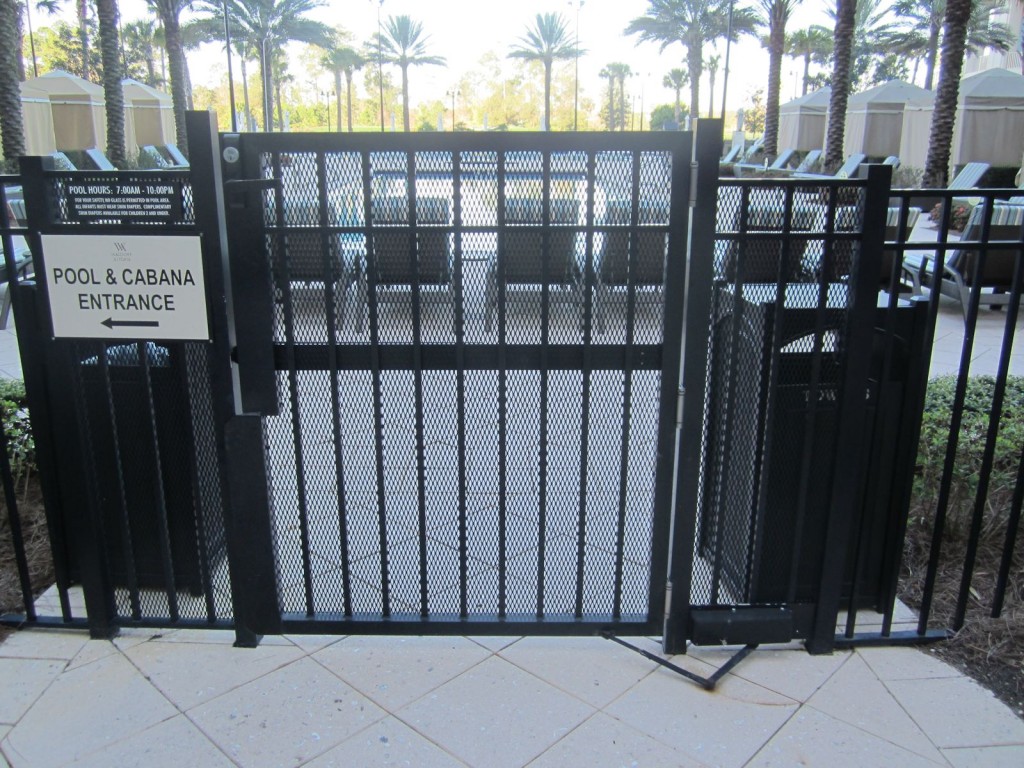
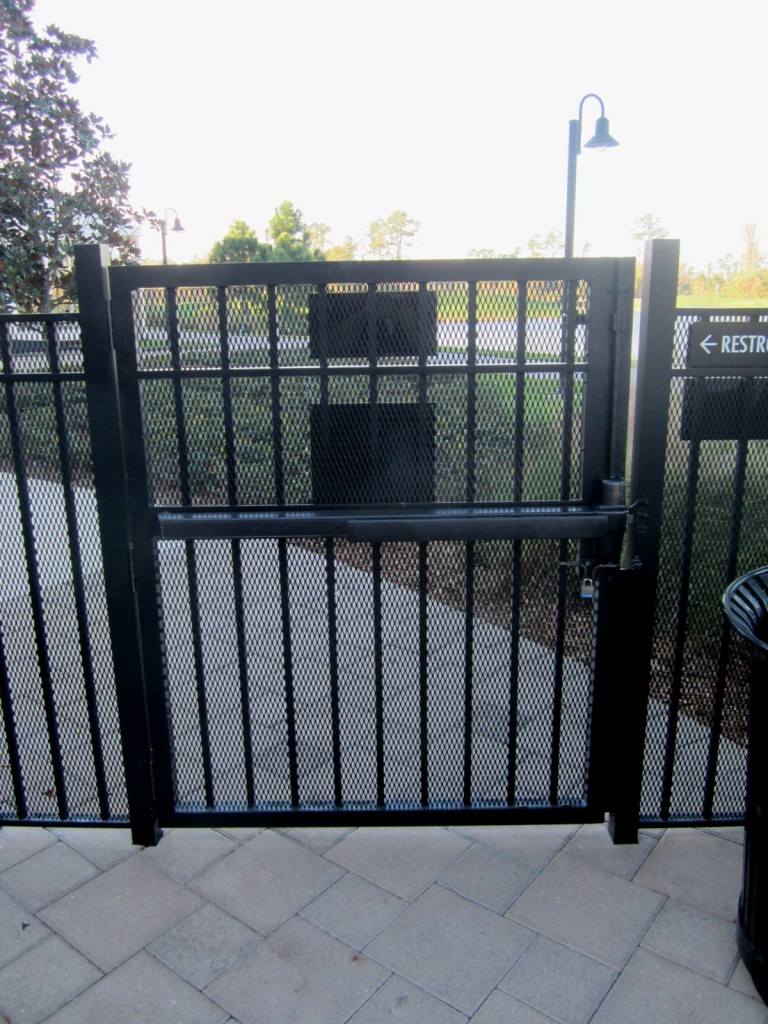
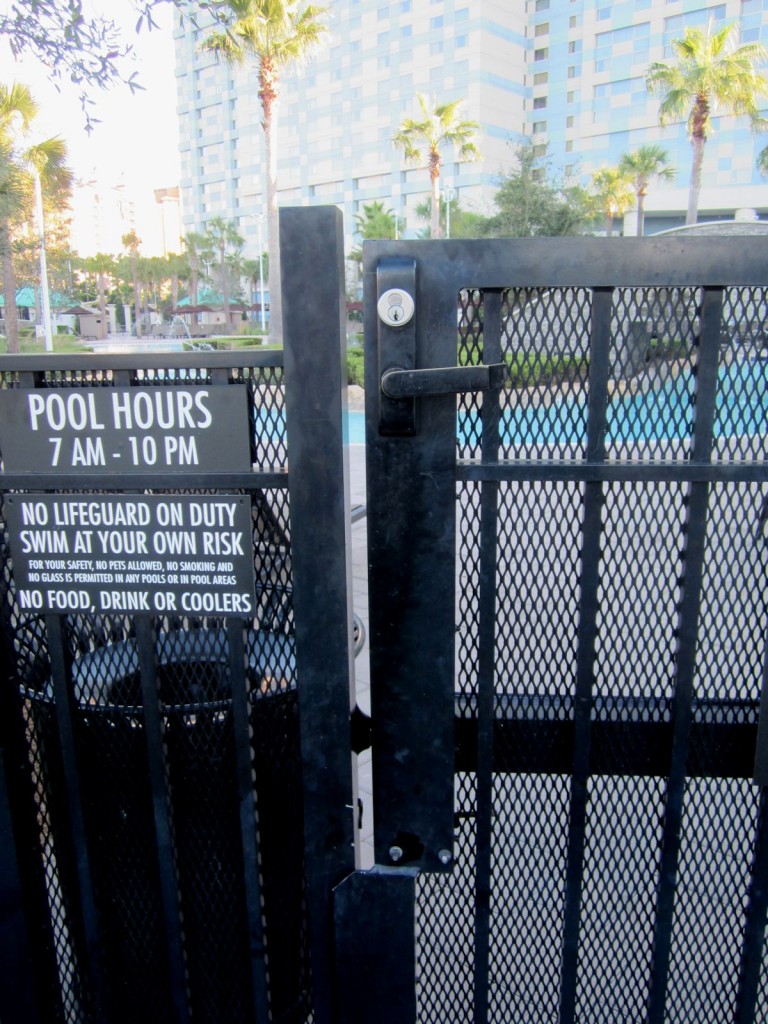
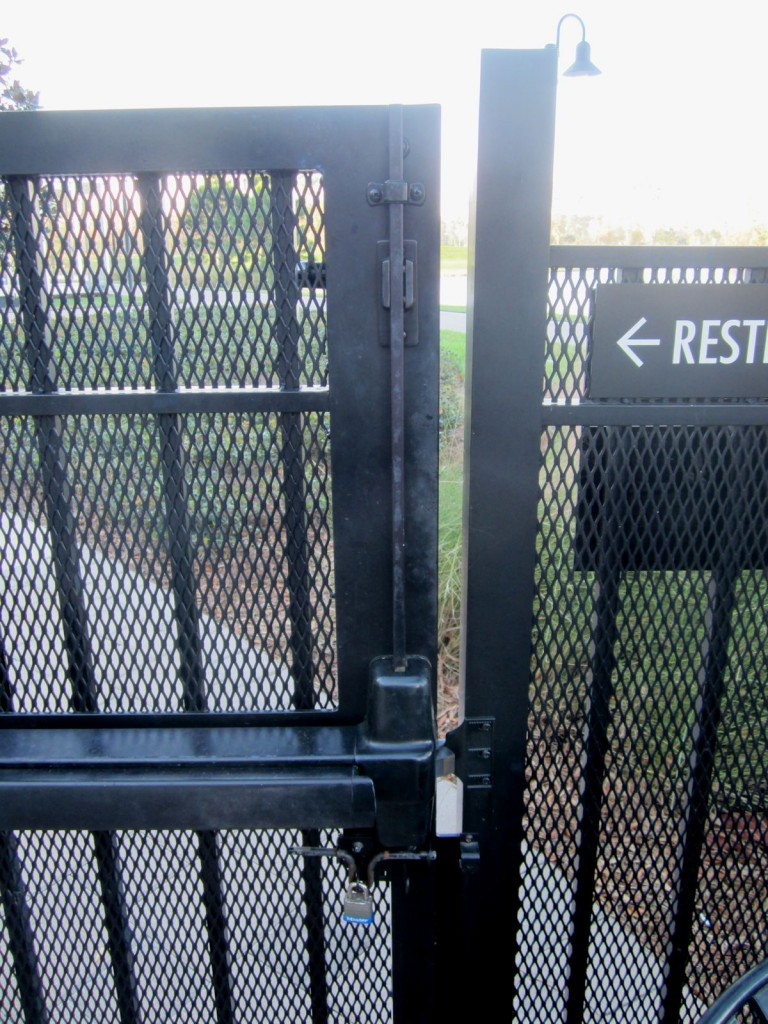
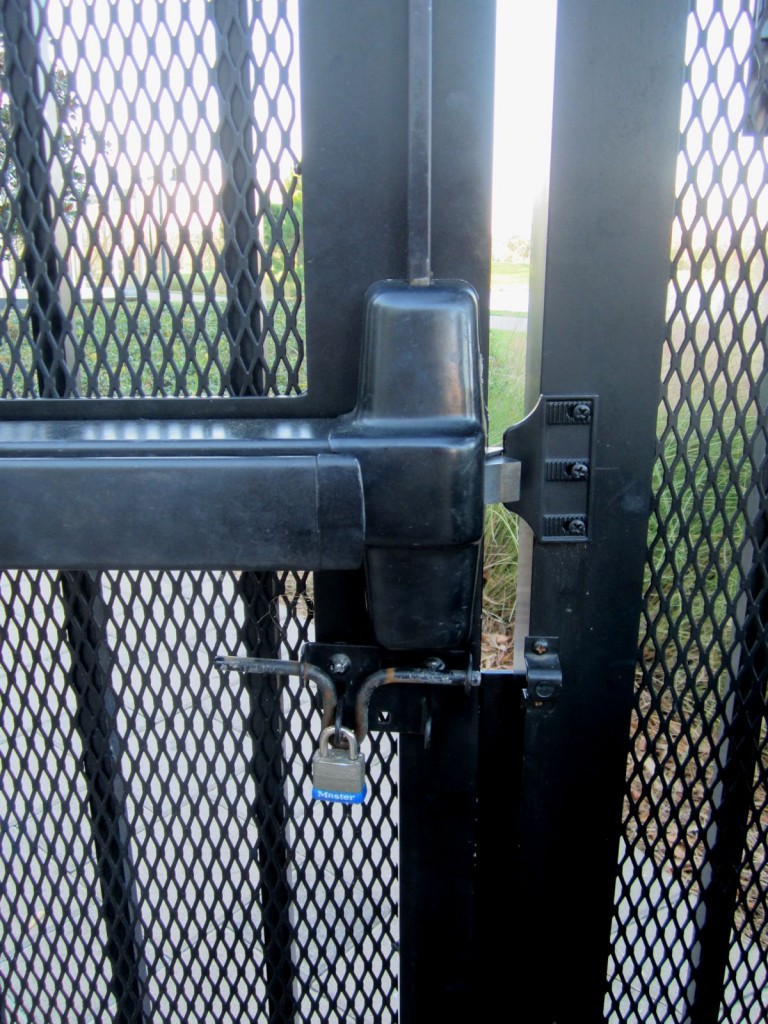

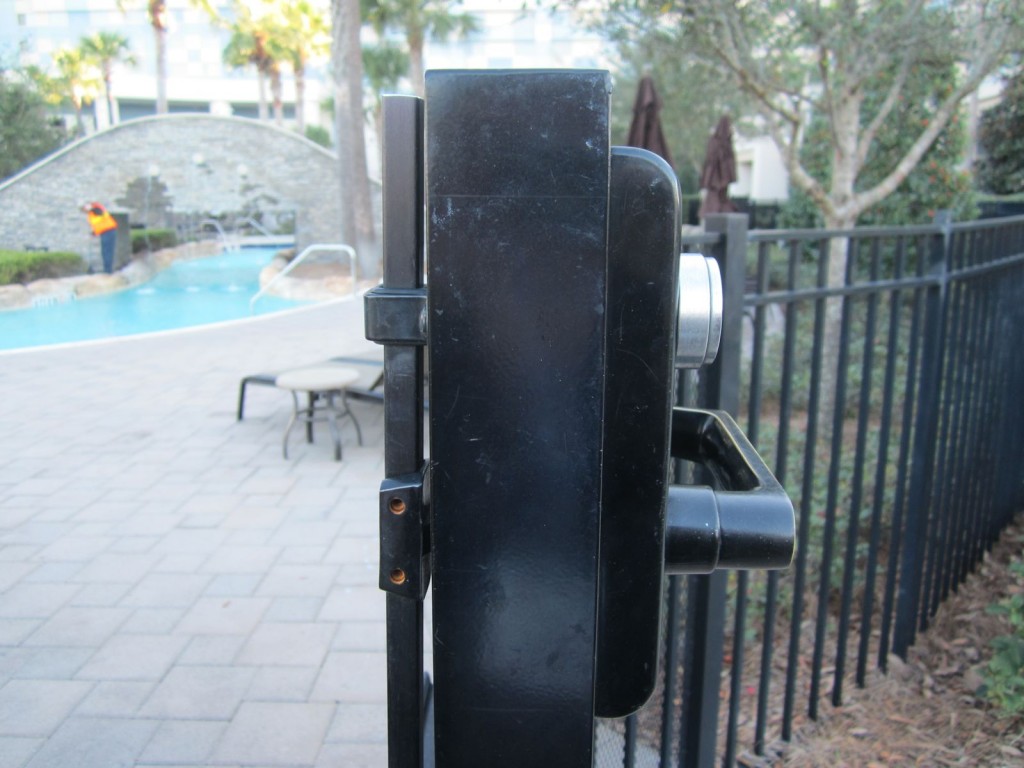





Is this type of exit device unique to Von Duprin? As for the closer, the wear marks on the tile indicate an improper installation. ; )
I don’t know if anyone else makes it. It was the first time I had seen anything like it, although our Florida specwriters knew all about it. We don’t have as many outdoor lazy rivers in my neck of the woods.
Pretty ingenious solution to the problem.
Looks like they had to add the padlockable surface bolt because you could just reach over the top of the gate and push down on the vertical rod to open the door even if the outside lever is locked.
Yes, that’s one of the problems with gates.
I do agree that the closer as installed could be better. How about a track type with bent arm? and special templating, obviously.
Nice hardware, horrible installation!
The closer even if code compliant is obviously an ethical trip hazard and should be changed out. Its probably rubbing the tile as shown in the photos from being stepped on. Spring hinges would suffice here or a floor check could be used.
D&D Technologies that makes the Magna Latch commonly used on pool gates has a nice new set of closer/hinge combinations that may work well here. Its new, and not a common gate spring type hinge but I havent seen appications in use yet.
Judging by the 1609 strike projection, the lock stile gap well exceeds the allowable 1/2″ maximum opening. The astragal shown below the exit device should continue above it to close off this area.
Maybe not on this gate but the other one had spring hinges but they had the spring removed or disengaged somehow. Mr. Jon Dudley who originally pointed out the gate brought that to my attention, as well. I assumed that the gates being 4′ wide where building up quite a force and slamming hard with the two original spring hinges.
why panic hardware? i see nothing in the Code to mandate it…
Hi Jay –
If it was an indoor pool it would be considered an Assembly occupancy and would require panic hardware if the occupant load was >50 (or >100 per NFPA 101 or the older editions of the IBC). Since this is an outdoor pool, I think the panics just allowed for this special application with the variance in height for the operating hardware on each side of the gate. Panic hardware is also used for durability and ease of operation.
– Lori
Lori and Jay:
I was told by local inspectors that our outdoor pool and terrace and an adjacent fenced-in courtyard on an apartment job in Rockville MD required panic hardware since the occupancy load was greater than 50.
Hi Chris –
I’ve been seeing that more often – outdoor pools considered Assembly space, and requiring panic hardware for an occupant load of 50 or more.
– Lori
For the door closer; The LCN tech support folks have been great at getting installation templates for gate mounted closers. This is great to get because you can mount on the top rail and be assured that the valves work correctly.
A pet peeve of mine;
Use a Cast Aluminum closer (like a LCN 4050)and non-ferrus fasteners in this situation to avoid problems caused by rust. Do NOT use a cast iron closer, yes they are tough, but it is all but impossible to keep them from rusting.
The code says that a door with more than 50 occupants requires panic hardware, it says nothing about a gate requiring panic hardware.
Hi Zac –
There are some situations where a gate is part of a means of egress and has to meet the same requirements as a door. Here’s where it says so in the IBC: “1010.2 Gates. Gates serving the means of egress system shall comply with the requirements of this section. Gates used as a component in a means of egress shall conform to the applicable requirements for doors.”
– Lori
Thanks Lori, I didn’t read that part carefully enough.
See the best gate closer in the industry http://www.locinox.com/en-us/product/2023/products/gate-closers/10819/mammoth-180.aspx
Thanks Bob that hardware looks very well thought out and perfect for this application.
The gate closer should be a Mammoth 180 ADA compliant self-closing hinge by Locinox. Is this LCN made only for indoor installations?
Hi Tom –
LCN has a special rust inhibitor finish and the standard fluid can handle temperatures from -30 degrees to 120 degrees F, so there isn’t usually a problem with mounting LCN closers on the exterior.
– Lori
Hey Lori,
Speaking with an Allegion rep earlier and it was stated that the warranty is void if installed outside.? He also indicated it would rust within a year.
You’re right – I checked with LCN and even though the warranty isn’t specific, the product will not be replaced under warranty if it has been installed outside. With that said, I’ve seen it done many times.
– Lori
Hi Lori-
I have a quick question. It states that Panic Hardware IS required on Indoor Pools, but not outdoor pools. Is that correct (WITH CVR Panic @ 34″-48″ from Pool Side & the Release Lever mounted @ 54″ AFF from access side, of course)?
Additionally, I am wanting to confirm that if we’re using a pair of egress doors that are leading to the outdoor pool area, the architect has those doors drawn as being swing out. However, from what I can find, it states “All Gates must swing AWAY from the pool”. Would that same rule apply for our Pair Egress Door leading to the Outdoor Pool? In essence, would those doors need to be switched to be In-Swinging Doors OR does that rule not apply since all commercial egress doors are usually required to Swing-OUT by code? Please advise. Thank you Lori!
– Rob Johnson
Hi Rob –
In the 5+ years since I wrote this blog post, it has become much more common to see panic hardware on outdoor pool enclosures. The IBC would require panic hardware if the occupant load of the enclosure is 50 people or more. Regarding the release lever on the access side of the gate – if the lever can be left unlocked, it must be mounted at 54″ AFF. But if the lever requires a key or access control credential to enter, the access hardware can be mounted at standard height (34-48″ AFF). The codes are not really clear about this, but I checked with the ICC and their answer is here: https://idighardware.com/2015/10/swimming-pool-access-control/.
The direction of swing for the doors leading from the building to the pool depends on whether the door is serving as a means of egress for the interior space and what the occupant load of that space is. Personally, I don’t like to see an egress path passing through a pool enclosure. If the doors are serving an interior assembly space with an occupant load of 50+, they must have panic hardware. But to prevent young children from accessing the pool, the panic hardware would have to be mounted at 54″ AFF. If the doors are not an egress path for the interior space, they could swing into the building but this could create a security problem if the doors are not locked on the pool side.
– Lori
Hi Lori –
Thank you very much for getting back to me & so quickly. So I have confirmed that Pair Door leading to the Outdoor Pool are in fact ‘Emergency Egress Doors’. Based on your response, it seems the solution is to mount the Panic Hardware @ 54″ AFF. HOWEVER, my concern is are we now having an issue meeting the ‘Pool Barrier Codes’ that all doors/gates leading to the pool must Swing-Outward/AWAY from the pool area? OR is there an exception to the rule in this case w/the pair being an ‘Emergency Egress Door’?
*I’ve noticed in the 2nd sentence of the 2nd paragraph above, it states: “Gates must swing away from the pool, and the release mechanism on the outside must be at least 54 inches from the bottom of the door or gate to prevent a young child from entering”*
**Additionally, I’ve found the following from our AHJ, ‘City of Phoenix – Pool Barrier Requirements’ that states: “All doors must be self-closing and self-latching and must swing outward from the pool area. A simple latch or lock located a minimum of 54 inches above the floor, or a double-keyed dead bolt at any height is acceptable”
I’ve reached out to them regarding clarification on my above question, but was hoping you may help shed some light, as I’ve had a hard time getting a response or answer from them as of yet. Thanks Lori!
Hi Rob –
Unfortunately I think you will have to wait for the AHJ on this one. There are several conflicting requirements – door swing, mounting height, etc., and they will have to make the final determination. I don’t agree with the use of a double cylinder deadbolt, because it is not code-compliant for egress when it’s locked, and when it’s unlocked it will not prevent unaccompanied children from entering.
– Lori
I agree; It’s definitely going to need panics in order to meet both codes. The only ones that we can’t seem to meet for both at this point are the contradicting door swings. I’m with you in this is a terrible idea/design. I have a feeling in this particular case it may be a break in the plans & the door will need to be changed from an egress door OR a separate barrier be placed around the outdoor pool. It’s a first in ever coming across this particular issue for me, so we shall see.
But I appreciate your help & feedback. FYI, I love this website & always check here if I ever need additional ideas or clarification. I think this is a very informative, well done website; keep up the great work!
I’ll wait for the local AHJ to get back to me & update this post if I happen to get some good information. Thanks again Lori!
Thanks Rob!
– Lori
Hello Our development has a 4″ vinyl/pvc clad fence surrounding the pool area. We are looking to add a 4′ high EMERGENCY EXIT ONLY gate equipped with a panic bar. Kindly inform me what you recommend. Thank you